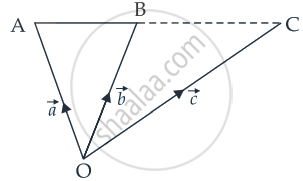Advertisements
Advertisements
Question
If `vec"a"` and `vec"b"` are the position vectors of A and B, respectively, find the position vector of a point C in BA produced such that BC = 1.5 BA.
Solution

Given that BC = 1.5 BA
⇒ `"BC"/"BA"` = 1.5 = `3/2`
⇒ `(vec"c" - vec"b")/(vec"a" - vec"b") = 3/2`
⇒ `2vec"c" - 2vec"b" = 3vec"a" - 3vec"b"`
⇒ `2vec"c" = 3vec"a" - 3vec"b" + 2vec"b"`
⇒ `2vec"c" = 3vec"a" - vec"b"`
∴ `vec"c" = (3vec"a" - vec"b")/2`
Hence, the required vector is `vec"c" = (3vec"a" - vec"b")/2`.
APPEARS IN
RELATED QUESTIONS
Find the direction ratios of a vector perpendicular to the two lines whose direction ratios are -2, 1, -1, and -3, -4, 1.
If `bara, barb, bar c` are the position vectors of the points A, B, C respectively and ` 2bara + 3barb - 5barc = 0` , then find the ratio in which the point C divides line segment AB.
Write the position vector of the point which divides the join of points with position vectors `3veca-2vecb and 2veca+3vecb` in the ratio 2 : 1.
Find the value of 'p' for which the vectors `3hati+2hatj+9hatk and hati-2phatj+3hatk` are parallel
Classify the following measures as scalar and vector.
10 kg
Classify the following as scalar and vector quantity.
Time period
`veca and -veca` are collinear.
Find the position vector of a point R which divides the line joining two points P and Q whose position vectors are `hati + 2hatj - hatk` and `-hati + hatj + hatk` respectively, externally in the ratio 2:1.
If θ is the angle between two vectors `veca` and `vecb`, then `veca . vecb >= 0` only when ______.
Express \[\vec{AB}\] in terms of unit vectors \[\hat{i}\] and \[\hat{j}\], when the points are A (−6, 3), B (−2, −5)
Find \[\left| \vec{A} B \right|\] in each case.
Find the angle between the vectors \[\vec{a} \text{ and } \vec{b}\] where \[\vec{a} = \hat{i} - \hat{j} \text{ and } \vec{b} = \hat{j} + \hat{k}\]
Find a unit vector parallel to the vector \[\hat{i} + \sqrt{3} \hat{j}\]
Find the angles which the vector \[\vec{a} = \hat{i} -\hat {j} + \sqrt{2} \hat{k}\] makes with the coordinate axes.
If \[\left| \vec{a} + \vec{b} \right| = 60, \left| \vec{a} - \vec{b} \right| = 40 \text{ and } \left| \vec{b} \right| = 46, \text{ find } \left| \vec{a} \right|\]
For any two vectors \[\vec{a} \text{ and } \vec{b}\] show that \[\left( \vec{a} + \vec{b} \right) \cdot \left( \vec{a} - \vec{b} \right) = 0 \Leftrightarrow \left| \vec{a} \right| = \left| \vec{b} \right|\]
If either \[\vec{a} = \vec{0} \text{ or } \vec{b} = \vec{0}\] then \[\vec{a} \cdot \vec{b} = 0 .\] But the converse need not be true. Justify your answer with an example.
Find the angles of a triangle whose vertices are A (0, −1, −2), B (3, 1, 4) and C (5, 7, 1).
Find the magnitude of two vectors \[\vec{a} \text{ and } \vec{b}\] that are of the same magnitude, are inclined at 60° and whose scalar product is 1/2.
If A, B and C have position vectors (0, 1, 1), (3, 1, 5) and (0, 3, 3) respectively, show that ∆ ABC is right-angled at C.
Show that the points \[A \left( 2 \hat{i} - \hat{j} + \hat{k} \right), B \left( \hat{i} - 3 \hat{j} - 5 \hat{k} \right), C \left( 3 \hat{i} - 4 \hat{j} - 4 \hat{k} \right)\] are the vertices of a right angled triangle.
Find the value of x for which \[x \left( \hat{i} + \hat{j} + \hat{k} \right)\] is a unit vector.
If \[\vec{a} \times \vec{b} = \vec{c} \times \vec{d} \text { and } \vec{a} \times \vec{c} = \vec{b} \times \vec{d}\] , show that \[\vec{a} - \vec{d}\] is parallel to \[\vec{b} - \vec{c}\] where \[\vec{a} \neq \vec{d} \text { and } \vec{b} \neq \vec{c}\] .
If A, B, C, D are the points with position vectors `hat"i" + hat"j" - hat"k", 2hat"i" - hat"j" + 3hat"k", 2hat"i" - 3hat"k", 3hat"i" - 2hat"j" + hat"k"`, respectively, find the projection of `vec"AB"` along `vec"CD"`.
The unit normal to the plane 2x + y + 2z = 6 can be expressed in the vector form as
Let (h, k) be a fixed point where h > 0, k > 0. A straight line passing through this point cuts the positive direction of the coordinate axes at the points P and Q. Then the minimum area of the ΔOPQ. O being the origin, is
If `veca, vecb, vecc` are vectors such that `[veca, vecb, vecc]` = 4, then `[veca xx vecb, vecb xx vecc, vecc xx veca]` =
